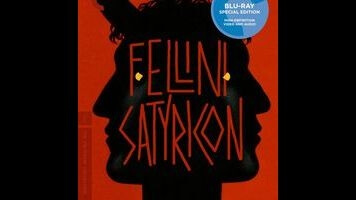Fellini Satyricon is the Italian director at his most decadent and tedious

When people refer to something as Fellini-esque, they’re never talking about his early work. The lyrical neorealism that pervades La Strada and Nights Of Cabiria, for example, is indisputably Fellini, but it isn’t remotely Fellini-esque, as that term is popularly used. Once you wade past articles that expressly discuss what the word signifies, Google search results point toward such films as Paolo Sorrentino’s recent The Great Beauty and Woody Allen’s Stardust Memories, which conjure up images of bizarre faces and grotesque carnival excess. There are Fellini-esque elements in classics like La Dolce Vita and 8½, but the movie that most aggressively embodies this aesthetic, for better and (much more often) worse, is 1969’s Fellini Satyricon, a nonstop parade of garish decadence that’s being released this week as part of the Criterion collection. Frequently marvelous to look at, the film is nevertheless something of a trial to endure; it feels dispiritingly like the work of a director who was reading way too much of his own press.
A big part of the problem is the fragmentary nature of the source material. Freely adapted from Petronius’s phantasmagorical epic, written during the reign of Nero (late in the 1st century A.D.), Satyrico loosely follows the alternately bloody and randy adventures of young poet Encolpius (Martin Potter), whose desperate infatuation with an androgynous boy (Max Born) gets him in all kinds of trouble. If that synopsis sounds a tad vague, there’s a good reason: No more than 25 percent of Petronius’ text has survived. Nor is the extant material contiguous—there are huge gaps throughout the text that render its narrative nonsensical. (Imagine that our only copies of The Hunger Games open with Katniss hanging around her house, looking vaguely concerned, then suddenly jump ahead to the Games with no explanation.) Fellini, working with screenwriter Bernardino Zapponi, opted to leave the holes intact, apparently energized by the idea of incompletion. Unfortunately, he fails to explore that idea in any meaningful way, and so the film comes across as merely incoherent, lurching randomly from one episode to the next.
Still, Satyricon might have been spasmodically enjoyable merely for the sake of its stupendous production design, had Fellini not decided to hire a bunch of mediocre English and American actors and dub them (poorly) into Italian. According to various supplements on the Criterion disc, the lack of synchronization between lips and words is a deliberate alienation effect, designed to heighten the strangeness; Fellini frequently referred to the film as science fiction set in our own past. But that’s like intentionally dropping the boom mic into the frame every few seconds in order to disorient viewers—the default assumption will be that something has gone awry in the projection booth, or that the director is inept. In any case, Encolpius’ various homoerotic escapades never achieve any emotional traction, and since the “story”—or what remains of the story—verges on random, there’s nothing to do but marvel at the colossal sets and the elaborate costumes. It’s a catalog of striking images in search of a compelling context (75 percent of which was destroyed), and while there’s no resemblance to contemporary Hollywood fare—which is hardly Fellini-esque—Satyricon inspires a similar feeling of exhaustion. Empty spectacle is empty spectacle.